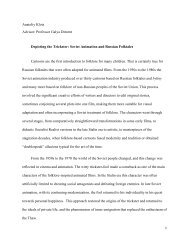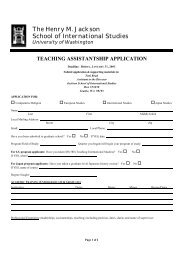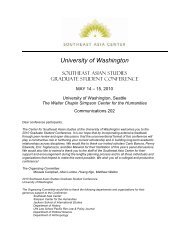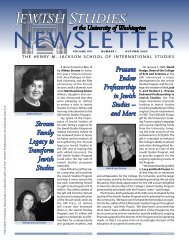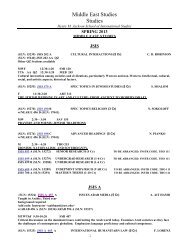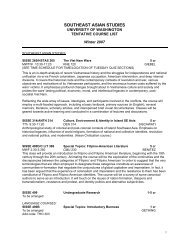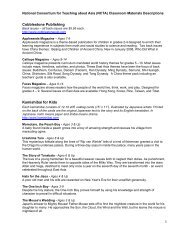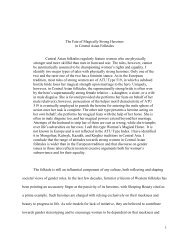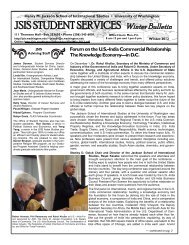Beyond Borders: Regional Partnerships in the Pacific Northwest
Beyond Borders: Regional Partnerships in the Pacific Northwest
Beyond Borders: Regional Partnerships in the Pacific Northwest
You also want an ePaper? Increase the reach of your titles
YUMPU automatically turns print PDFs into web optimized ePapers that Google loves.
The Canadian Studies Center<br />
Henry M. Jackson School of International Studies<br />
Occasional Paper Series on<br />
Canada-U.S. Relations<br />
Dr. Sukumar Periwal<br />
<strong>Beyond</strong> <strong>Borders</strong>:<br />
<strong>Regional</strong> <strong>Partnerships</strong><br />
<strong>in</strong> <strong>the</strong> <strong>Pacific</strong> <strong>Northwest</strong><br />
February 2007
The Canadian Studies Centerr,<br />
Henry M. Jackson School<br />
of International Studies<br />
Occasional<br />
Paper Series on<br />
Canada-U.S.<br />
Relations<br />
Dr. Sukumar Periwal<br />
<strong>Beyond</strong> <strong>Borders</strong>:<br />
<strong>Regional</strong> <strong>Partnerships</strong><br />
<strong>in</strong> <strong>the</strong> <strong>Pacific</strong> <strong>Northwest</strong><br />
February 2007
Henry M. Jackson School of International Studies<br />
The Henry M. Jackson School of International Studies comb<strong>in</strong>es <strong>the</strong> social<br />
sciences, humanities, and professional fields to enhance our understand<strong>in</strong>g of<br />
our <strong>in</strong>creas<strong>in</strong>gly <strong>in</strong>terconnected globe. The school is named for <strong>the</strong> late Senator<br />
Henry M. Jackson, <strong>in</strong> recognition of his <strong>in</strong>terest and support for <strong>the</strong> school and<br />
for <strong>the</strong> field of <strong>in</strong>ternational affairs. The Jackson School’s commitment to regional,<br />
cross-cultural, and comparative studies extends well beyond <strong>the</strong> boundaries of its<br />
many formal academic programs. The school has eight Title VI National Resource<br />
Centers <strong>in</strong>clud<strong>in</strong>g Canadian Studies; East Asia Center; Center for West European<br />
Studies; International Studies; Middle East Studies; Ellison Center for Russian,<br />
East European, & Central Asian Studies; South Asian Studies; and Sou<strong>the</strong>ast Asian<br />
Studies – devoted to outreach and public education activities.<br />
Canadian Studies Center<br />
The Canadian Studies Center, one of <strong>the</strong> Jackson School’s eight Title VI centers,<br />
forms a National Resource Center with <strong>the</strong> Center for Canadian-American<br />
Studies at Western Wash<strong>in</strong>gton University. Founded <strong>in</strong> 1986, <strong>the</strong> Center promotes<br />
comparative Canadian content <strong>in</strong> <strong>the</strong> curriculum and with faculty and graduate<br />
research projects. Currently Canada is represented by faculty and research scientists<br />
<strong>in</strong> 17 departments <strong>in</strong> Arts and Sciences, 11 of <strong>the</strong> University’s professional schools<br />
and U.W. Seattle, Tacoma and Bo<strong>the</strong>ll. The Program hosts an undergraduate<br />
degree, a Professional Development Program for graduate students, and has<br />
a grant for Foreign Language and Area Studies Fellowships. The mission of <strong>the</strong><br />
Center is to <strong>in</strong>crease knowledge about Canada and <strong>the</strong> Canada-U.S. relationship<br />
at <strong>the</strong> University, with local bus<strong>in</strong>ess leaders and public officials, K-12 educators<br />
regionally and nationally, and <strong>the</strong> American general public.<br />
Canada-U.S. Fulbright Program<br />
The Canada-U.S. Fulbright Program is a bi-national program supported by<br />
<strong>the</strong> Government of Canada, through <strong>the</strong> Department of Foreign Affairs and<br />
International Trade Canada, <strong>the</strong> Government of <strong>the</strong> United States, through <strong>the</strong><br />
Department of State, and a large number of public and private sector partners.<br />
The mandate of <strong>the</strong> Canada-U.S. Fulbright Program is to enhance mutual<br />
understand<strong>in</strong>g between <strong>the</strong> people of Canada and <strong>the</strong> people of <strong>the</strong> United States<br />
by provid<strong>in</strong>g support to outstand<strong>in</strong>g graduate students, faculty, professionals and<br />
<strong>in</strong>dependent researchers.
Dr. Sukumar Periwal<br />
Dr. Sukumar Periwal is <strong>the</strong> first<br />
recipient of <strong>the</strong> new Fulbright Visit<strong>in</strong>g<br />
Chair <strong>in</strong> Canadian Studies at <strong>the</strong><br />
University of Wash<strong>in</strong>gton. Dr. Periwal,<br />
Director of International Relations for<br />
British Columbia’s Intergovernmental<br />
Relations Secretariat, took up <strong>the</strong><br />
Chair <strong>in</strong> Fall 2006 and will cont<strong>in</strong>ue<br />
his tenure until <strong>the</strong> end of W<strong>in</strong>ter<br />
Quarter 2007.<br />
The goal of <strong>the</strong> Chair is to <strong>in</strong>crease<br />
cross-border collaboration and<br />
effective mechanisms for dispute resolution that are central to ensur<strong>in</strong>g North<br />
America’s competitiveness <strong>in</strong> <strong>the</strong> global economy. As both a scholar and a<br />
practitioner, Dr. Periwal is <strong>in</strong> an ideal position to contribute to this pursuit.<br />
Dr. Periwal’s research project considers cross-border organizations and<br />
<strong>in</strong>tergovernmental l<strong>in</strong>kages <strong>in</strong> <strong>the</strong> <strong>Pacific</strong> <strong>Northwest</strong> <strong>in</strong> order to evaluate <strong>the</strong>ir<br />
effectiveness <strong>in</strong> resolv<strong>in</strong>g border issues and trade disputes, diffus<strong>in</strong>g bus<strong>in</strong>ess best<br />
practices and enhanc<strong>in</strong>g North American competitiveness. This research is relevant<br />
to Canada-U.S. relations, North American <strong>in</strong>tegration, border issues, <strong>in</strong>ternational<br />
trade and conflict resolution.<br />
Periwal completed his doctorate <strong>in</strong> <strong>in</strong>ternational relations at <strong>the</strong> University<br />
of Oxford and participated <strong>in</strong> <strong>the</strong> prestigious Canadian Governor General’s<br />
Leadership Conference <strong>in</strong> 2004. In addition to his work for <strong>the</strong> B.C. government,<br />
he also frequently facilitates courses at <strong>the</strong> University of British Columbia’s Centre<br />
for Intercultural Communication.
<strong>Beyond</strong> <strong>Borders</strong>:<br />
<strong>Regional</strong> <strong>Partnerships</strong><br />
<strong>in</strong> <strong>the</strong> <strong>Pacific</strong> <strong>Northwest</strong><br />
A new form of <strong>in</strong>ternational cooperation is tak<strong>in</strong>g shape <strong>in</strong> <strong>the</strong> <strong>Pacific</strong> <strong>Northwest</strong><br />
region of North America, an adaptive amalgam of known political arrangements<br />
and experimental modes of democratic dialogue and action. The bones of<br />
conventional bilateral and multilateral <strong>in</strong>tergovernmental agreements are be<strong>in</strong>g<br />
fleshed out with ad-hoc coalitions and work<strong>in</strong>g groups that are start<strong>in</strong>g to flex <strong>the</strong>ir<br />
muscle. And underly<strong>in</strong>g <strong>the</strong> formal structures, a flexible and <strong>in</strong>tertw<strong>in</strong>ed ‘neural<br />
network’ of regional organizations is stimulat<strong>in</strong>g <strong>in</strong>teraction and <strong>in</strong>formationshar<strong>in</strong>g<br />
between governments, bus<strong>in</strong>esses, activists and <strong>in</strong>digenous peoples, like a<br />
dense web of neurons spark<strong>in</strong>g more and more ideas and personal connections.<br />
WHAT MAKES THE PACIFIC NORTHWEST SPECIAL?<br />
The <strong>Pacific</strong> <strong>Northwest</strong> offers best practices <strong>in</strong> partner<strong>in</strong>g across borders with <strong>the</strong><br />
overall goal of promot<strong>in</strong>g <strong>the</strong> whole region’s global competitiveness to get beyond<br />
fruitless conflict and <strong>in</strong>creas<strong>in</strong>g beneficial cooperation. <strong>Regional</strong> cooperation <strong>in</strong><br />
<strong>the</strong> <strong>Pacific</strong> <strong>Northwest</strong> is special because of three def<strong>in</strong><strong>in</strong>g features:<br />
• First, <strong>the</strong> region is strategically located as a gateway between North America and<br />
<strong>the</strong> Asia <strong>Pacific</strong>, as a cross-border community between Canada and <strong>the</strong> United<br />
States, and as a network of vibrant urban centers <strong>in</strong>clud<strong>in</strong>g Vancouver, Seattle,<br />
Calgary, Edmonton, Boise, Portland and Victoria.<br />
• Second, an <strong>in</strong>tense and <strong>in</strong>formed dialogue on economic and environmental<br />
susta<strong>in</strong>ability among activists, bus<strong>in</strong>esses, and governments has led to efforts<br />
to bridge <strong>the</strong> divides between natural resource extraction and environmental<br />
protection through <strong>in</strong>novative partnerships and technology <strong>in</strong>novation that<br />
are showcased at <strong>in</strong>ternationally recognized events such as <strong>the</strong> biannual Globe<br />
conference and <strong>the</strong> upcom<strong>in</strong>g 2010 W<strong>in</strong>ter Olympic and Paralympic Games <strong>in</strong><br />
Vancouver.<br />
• Third, <strong>the</strong> structural l<strong>in</strong>kages between <strong>the</strong> states and prov<strong>in</strong>ces of <strong>the</strong> <strong>Pacific</strong><br />
<strong>Northwest</strong> – bilateral and multilateral agreements on economic cooperation<br />
| 7 |
and emergency preparedness – provide a critical impetus for o<strong>the</strong>r issue-specific<br />
coalitions, alliances and partnerships. These ‘bottom-up’ <strong>in</strong>itiatives, often fostered<br />
and encouraged by an <strong>in</strong>novative regional organization called <strong>the</strong> <strong>Pacific</strong> North<br />
West Economic Region (PNWER), enable <strong>the</strong> region to identify and articulate<br />
shared priorities and concerns with a dist<strong>in</strong>ctive voice.<br />
As <strong>the</strong> center of economic gravity shifts towards <strong>the</strong> <strong>Pacific</strong> Rim, this model of<br />
regional partnership will become <strong>in</strong>creas<strong>in</strong>gly important for <strong>the</strong> future prosperity<br />
and security of North America and as a role model for regions <strong>in</strong> o<strong>the</strong>r parts of<br />
<strong>the</strong> world. After September 11, 2001, it is no longer possible to argue that <strong>the</strong><br />
nation-state is irrelevant <strong>in</strong> an age of globalization. The grim reality of terrorism<br />
and <strong>in</strong>ternational violence has re<strong>in</strong>forced <strong>the</strong> state’s primary role as <strong>the</strong> provider<br />
of security for its citizens. However, <strong>the</strong> dizzy<strong>in</strong>g technological, economic and<br />
demographic shifts that are mak<strong>in</strong>g <strong>the</strong> world ‘flat’ (<strong>in</strong> Thomas Friedman’s term)<br />
cont<strong>in</strong>ue to accelerate as well. S<strong>in</strong>ce 9/11, <strong>the</strong> key challenge for policy makers has<br />
been to reconcile <strong>the</strong> often contradictory imperatives of security and prosperity.<br />
Cross-border regional cooperation <strong>in</strong> <strong>the</strong> <strong>Pacific</strong> <strong>Northwest</strong> offers useful lessons <strong>in</strong><br />
how to use borders, not as ever higher walls of suspicion and sullen <strong>in</strong>sularity, but<br />
as good fences that make even better neighbors who are able to learn from each<br />
o<strong>the</strong>r and profit from our differences.<br />
Globalization has caused, and also made us more aware of, <strong>the</strong> complex challenges<br />
humans face as a species <strong>in</strong> <strong>the</strong> first half of <strong>the</strong> 21st century. Climate change with<br />
its manifold associated impacts (<strong>in</strong>clud<strong>in</strong>g floods, droughts, ris<strong>in</strong>g coastal water<br />
levels and chang<strong>in</strong>g flows of ocean currents, <strong>the</strong> melt<strong>in</strong>g of glaciers and snowpacks,<br />
species migration and ext<strong>in</strong>ction, and ris<strong>in</strong>g energy requirements and constra<strong>in</strong>ts),<br />
<strong>the</strong> renewed and unpredictable onslaught of deadly diseases that may resist exist<strong>in</strong>g<br />
medic<strong>in</strong>es and be able to mutate faster than our capacity to generate vacc<strong>in</strong>es, <strong>the</strong><br />
horrify<strong>in</strong>g effects of natural catastrophes like earthquakes and tsunamis, magnified<br />
<strong>in</strong> an age of unprecedented urban concentration – all <strong>the</strong>se challenges demand<br />
global responses that have not been forthcom<strong>in</strong>g from a fragmented <strong>in</strong>ternational<br />
community composed of nation-states that are for <strong>the</strong> most part paralyzed by<br />
partisan politics, powerful domestic lobbies and short-sighted self-<strong>in</strong>terest.<br />
Too often, <strong>in</strong>tergovernmental responses are half-hearted agreements designed to<br />
achieve maximum publicity while only meet<strong>in</strong>g <strong>the</strong> lowest common denom<strong>in</strong>ator,<br />
too late and too little, and rarely, if ever, actually implemented. While governments<br />
are usually effective at deliver<strong>in</strong>g specific programs <strong>in</strong> designated areas of<br />
jurisdiction for which political leaders believe <strong>the</strong>re is a popular mandate, <strong>the</strong>y<br />
| 8 |
are not designed to respond proactively to challenges that exceed <strong>the</strong>ir scope and<br />
capacity to deliver results. As members of a species organized <strong>in</strong>to political units<br />
that are dysfunctional for deal<strong>in</strong>g with challenges beyond <strong>the</strong>ir particular grasp,<br />
our behavior resembles <strong>the</strong> frog sitt<strong>in</strong>g <strong>in</strong> a pot of water that is gradually be<strong>in</strong>g<br />
heated up. The frog’s <strong>in</strong>ability to grasp what is happen<strong>in</strong>g as <strong>the</strong> water approaches<br />
boil<strong>in</strong>g po<strong>in</strong>t is perilously similar to our own state of denial.<br />
In contrast, <strong>the</strong> noted economist Amartya Sen offers ano<strong>the</strong>r story of a frog “that<br />
is born <strong>in</strong> a well, and stays <strong>in</strong> <strong>the</strong> well and lives its entire life <strong>in</strong> <strong>the</strong> well. It has a<br />
worldview that consists of <strong>the</strong> well… That was what <strong>the</strong> world was like for many<br />
people on <strong>the</strong> planet before <strong>the</strong> fall of <strong>the</strong> [Berl<strong>in</strong>] wall. When it fell, it was like<br />
<strong>the</strong> frog <strong>in</strong> <strong>the</strong> well was suddenly able to communicate with frogs <strong>in</strong> all <strong>the</strong> o<strong>the</strong>r<br />
wells…. If I celebrate <strong>the</strong> fall of <strong>the</strong> wall, it is because I am conv<strong>in</strong>ced of how much<br />
we can learn from each o<strong>the</strong>r. Most knowledge is learn<strong>in</strong>g from o<strong>the</strong>rs across <strong>the</strong><br />
border.”<br />
The fall of <strong>the</strong> Berl<strong>in</strong> Wall <strong>in</strong> November 1989 <strong>in</strong>spired a few visionary legislators<br />
on <strong>the</strong> o<strong>the</strong>r side of <strong>the</strong> planet to come up with a new way of ‘learn<strong>in</strong>g from o<strong>the</strong>rs<br />
across <strong>the</strong> border.’ Alberta’s Deputy Premier Jim Horsman and Wash<strong>in</strong>gton State<br />
Senate President pro tem Alan Bluechel reasoned that two rich and self-confident<br />
countries like Canada and <strong>the</strong> United States with a history of trust, cooperation<br />
and shared traditions of democracy, <strong>the</strong> rule of law and free markets, would be able<br />
to cooperate effectively at <strong>the</strong> regional level to f<strong>in</strong>d mutual w<strong>in</strong>s. Toge<strong>the</strong>r with<br />
like-m<strong>in</strong>ded leaders <strong>in</strong> neighbour<strong>in</strong>g jurisdictions, <strong>the</strong>y established a forum for<br />
legislators that soon evolved <strong>in</strong>to a regional partnership <strong>in</strong>clud<strong>in</strong>g <strong>the</strong> private sector.<br />
The <strong>in</strong>itial effort has s<strong>in</strong>ce grown <strong>in</strong>to a remarkable regional network that has<br />
spread throughout <strong>the</strong> <strong>Pacific</strong> <strong>Northwest</strong>, becom<strong>in</strong>g an alternative way to generate<br />
<strong>in</strong>novative ideas, experiment on a small scale, and share ‘best practices’ with o<strong>the</strong>rs<br />
<strong>in</strong> <strong>the</strong> region who also face similar challenges. This ‘open source’ approach stands<br />
<strong>in</strong> radical contrast to <strong>the</strong> ‘top-down’ model of traditional <strong>in</strong>ternational <strong>in</strong>teraction<br />
based on <strong>the</strong> nation-state as <strong>the</strong> only legitimate actor on <strong>the</strong> <strong>in</strong>ternational arena.<br />
THE VALUE OF THE REGION<br />
To date, regional cooperation <strong>in</strong> <strong>the</strong> <strong>Pacific</strong> <strong>Northwest</strong> has mostly consisted of<br />
dialogue among legislators, private sector leaders and government officials. Results<br />
have not gone much beyond mak<strong>in</strong>g contact with counterparts and potential<br />
partners, shar<strong>in</strong>g <strong>in</strong>formation and potential “best practices”, and jo<strong>in</strong>t advocacy<br />
to decision-makers at <strong>the</strong> federal level. There have been no concerted efforts to<br />
| 9 |
establish structures or <strong>in</strong>stitutions with sufficient mandate, popular legitimacy and<br />
resources to make decisions at <strong>the</strong> regional level. If one buys <strong>in</strong>to an “<strong>in</strong>stitutional”<br />
model of regionalism or governance, it would be easy to dismiss <strong>the</strong>se cooperative<br />
efforts as <strong>the</strong> attempts, with limited success, by peripheral elites to coord<strong>in</strong>ate <strong>the</strong>ir<br />
voices so that <strong>the</strong>y can ga<strong>in</strong> greater hear<strong>in</strong>g at <strong>the</strong> centre, where fund<strong>in</strong>g, power and<br />
legitimacy are located and decisions really get made. After all, both Canada and<br />
<strong>the</strong> United States are successful states, able to provide <strong>the</strong>ir citizens with very high<br />
levels of economic and environmental well-be<strong>in</strong>g through considerable <strong>in</strong>vestment<br />
<strong>in</strong> public <strong>in</strong>frastructure and manageable levels of taxation and debt. Fur<strong>the</strong>rmore,<br />
despite long-term trends of decreas<strong>in</strong>g voter turnout and <strong>the</strong> political divides created<br />
by closely contested elections, both federal governments can claim a reasonable<br />
measure of legitimacy as represent<strong>in</strong>g more or less functional democracies.<br />
From this perspective, prov<strong>in</strong>ces, states and o<strong>the</strong>r regional actors are relatively<br />
marg<strong>in</strong>al decision-makers who would be best advised to stick to <strong>the</strong>ir knitt<strong>in</strong>g and<br />
provide services <strong>in</strong> <strong>the</strong>ir areas of jurisdiction and competency, such as education,<br />
health care, and public safety, where room for cross-border cooperation has<br />
historically been relatively limited due to systemic differences. A state-centric<br />
approach to cross-border cooperation, <strong>the</strong>n, would see limited scope for regional<br />
cooperation, ei<strong>the</strong>r on a bilateral level between neighbour<strong>in</strong>g states and prov<strong>in</strong>ces,<br />
or multilaterally through regional organizations.<br />
At first sight, <strong>the</strong> lack of <strong>in</strong>stitution-build<strong>in</strong>g on <strong>the</strong> regional level would appear<br />
to support <strong>the</strong> centralist argument that <strong>the</strong>re is not much appetite or capacity for<br />
significant regional cooperation. This approach assumes a correlation between <strong>the</strong><br />
existence of an <strong>in</strong>stitutional apparatus and <strong>the</strong> ability to deliver results. However, as<br />
James Hillman has po<strong>in</strong>ted out, <strong>the</strong> network has become <strong>the</strong> preferred contemporary<br />
concept for power: “<strong>the</strong> images of flow, feedback, distributive energy, touch<strong>in</strong>g<br />
all <strong>the</strong> bases, balanc<strong>in</strong>g constituencies, delivery - an <strong>in</strong>determ<strong>in</strong>ate field of almost<br />
random forces - are <strong>the</strong> new images of power. Not <strong>the</strong> heart but <strong>the</strong> capillaries.” A<br />
network <strong>the</strong>ory of power would value contacts over <strong>in</strong>stitutions, access ra<strong>the</strong>r than<br />
formal negotiations, consensus ra<strong>the</strong>r than b<strong>in</strong>d<strong>in</strong>g legal <strong>in</strong>struments and treaty<br />
obligations.<br />
Understand<strong>in</strong>g power as a network is especially relevant to Canada-U.S. relations<br />
for five reasons:<br />
• First, <strong>the</strong> U.S. political system structurally supports a diffusion of power among<br />
different actors, through constitutional means such as checks and balances<br />
| 10 |
etween <strong>the</strong> three branches of government and <strong>the</strong> often reiterated doctr<strong>in</strong>e of<br />
states' rights, and also through relatively loose party discipl<strong>in</strong>e and <strong>the</strong> capacity<br />
of <strong>in</strong>dividual legislators to act <strong>in</strong> <strong>the</strong>ir particular constituents' (and <strong>the</strong>ir own<br />
political) <strong>in</strong>terests.<br />
• Second, <strong>the</strong> differences <strong>in</strong> size and structure between <strong>the</strong> U.S. federal system and<br />
<strong>the</strong> Canadian confederation require <strong>in</strong>creased understand<strong>in</strong>g, not just from <strong>the</strong><br />
perspective of <strong>the</strong> center, but also from <strong>the</strong> periphery. A state like California,<br />
for <strong>in</strong>stance, has a population of 32 million, more than all of Canada. Yet <strong>the</strong><br />
Governor of California is only one of fifty governors, each compet<strong>in</strong>g for national<br />
attention and <strong>in</strong>ternational stand<strong>in</strong>g, work<strong>in</strong>g with<strong>in</strong> a complex political context<br />
<strong>in</strong>volv<strong>in</strong>g U.S. Senators, state legislators, and o<strong>the</strong>r state-wide elected and<br />
appo<strong>in</strong>ted officials. In o<strong>the</strong>r words, a Canadian legislator or bureaucrat needs<br />
to recognize <strong>the</strong> cognitive dissonance with an American counterpart with very<br />
different jurisdictional scope and capacity.<br />
• Third, <strong>the</strong> proliferation and highly vocal articulation of <strong>in</strong>terests has fragmented<br />
<strong>the</strong> once predictable nature of <strong>in</strong>fluence and stakeholder op<strong>in</strong>ion. Although <strong>the</strong><br />
value added by traditional lobby<strong>in</strong>g will cont<strong>in</strong>ue to rema<strong>in</strong> a useful means to<br />
sift through <strong>the</strong> <strong>in</strong>formation barrage faced by busy politicians and <strong>the</strong>ir staffers,<br />
<strong>the</strong> ability to pull toge<strong>the</strong>r coalitions of diverse <strong>in</strong>terests that bridge <strong>in</strong>dustry,<br />
constituency and political divides has become <strong>in</strong>creas<strong>in</strong>gly important.<br />
• Fourth, regional cooperation enables governments to <strong>in</strong>teract more effectively<br />
with grass-roots democracy by br<strong>in</strong>g<strong>in</strong>g <strong>in</strong> expertise <strong>in</strong> implementation and <strong>the</strong><br />
capacity to veto ideas that would have negative effects. Conversely, participation<br />
by democratically elected legislators adds legitimacy to <strong>the</strong> grass-roots effort.<br />
• Lastly, global challenges require a more open, <strong>in</strong>clusive and decentralized<br />
approach to many decisions. Thanks to <strong>the</strong> exponential rapidity with which<br />
global transmission and communication modes have evolved, a biological or<br />
electronic <strong>in</strong>fection that orig<strong>in</strong>ated <strong>in</strong> a seem<strong>in</strong>gly remote location now has <strong>the</strong><br />
potential to become a global pandemic with a speed that cannot be dealt with by a<br />
traditional “command and control” model of decision-mak<strong>in</strong>g. In crisis situations,<br />
communications l<strong>in</strong>es with <strong>the</strong> centre may break down and local authorities may<br />
be forced to act <strong>in</strong>dependently and utilis<strong>in</strong>g ad hoc networks. These ‘coalitions<br />
of <strong>the</strong> available’ may be aligned on a rough functional subsidiarity and familiarity<br />
with colleagues across organizational and national divides. Trust is <strong>the</strong> key to<br />
work<strong>in</strong>g effectively toge<strong>the</strong>r.<br />
| 11 |
The region will not replace <strong>the</strong> nation-state, just as <strong>the</strong> ‘open source’ <strong>in</strong>tellectual<br />
commons movement will not displace <strong>the</strong> corporation. However, <strong>the</strong>se new<br />
self-organized collaborative communities are re<strong>in</strong>vent<strong>in</strong>g politics and bus<strong>in</strong>ess,<br />
<strong>in</strong>creas<strong>in</strong>g transactional efficiencies and voluntary participation <strong>in</strong> <strong>the</strong> public arena.<br />
As adaptive networks, <strong>the</strong>y <strong>in</strong>crease our overall capacity to respond to complex<br />
challenges <strong>in</strong> timely and <strong>in</strong>novative ways. The state could use <strong>the</strong> assistance<br />
of regional networks to <strong>in</strong>crease voluntary participation <strong>in</strong> public life, renew<br />
democracy and f<strong>in</strong>d solutions for challenges beyond its own capacity. As social<br />
forms predicated on trust, <strong>the</strong>se collaborative communities improve our overall<br />
capacity to both compete and cooperate for mutual benefit. Instead of sitt<strong>in</strong>g <strong>in</strong><br />
our pot quietly stew<strong>in</strong>g, we strike up friendships with <strong>the</strong> o<strong>the</strong>r frogs that enable<br />
us to discover common concerns and shared solutions.<br />
BENEFITS OF REGIONAL COOPERATION<br />
The key benefits of regional cooperation are: first, <strong>in</strong>creas<strong>in</strong>g prosperity through<br />
regulatory cooperation and promot<strong>in</strong>g cross-border trade and <strong>in</strong>vestment; second,<br />
actively facilitat<strong>in</strong>g <strong>the</strong> resolution of border issues and trade conflicts; and third,<br />
enhanc<strong>in</strong>g North America’s global competitiveness.<br />
Increas<strong>in</strong>g prosperity<br />
There is a significant disparity between, on <strong>the</strong> one hand, <strong>the</strong> enormous volumes of<br />
cross-border trade and economic <strong>in</strong>terdependence between Canada and <strong>the</strong> United<br />
States, and, on <strong>the</strong> o<strong>the</strong>r hand, <strong>the</strong> ostentatious lack of high-level vision and political<br />
engagement on <strong>the</strong> challenges <strong>the</strong> countries face, both bilaterally and <strong>in</strong> <strong>the</strong> trilateral<br />
North American context. Economic and political discussions among governments<br />
cont<strong>in</strong>ue to take place <strong>in</strong> a dist<strong>in</strong>ctively North American way – through low-key<br />
work<strong>in</strong>g groups, focused on pragmatic and immediate concerns, often driven by<br />
<strong>the</strong> private sector, and with m<strong>in</strong>imal <strong>in</strong>vestment <strong>in</strong> <strong>in</strong>stitution-build<strong>in</strong>g. As Gary<br />
Clyde Hufbauer and Jeffrey Schott observe, “NAFTA was designed with m<strong>in</strong>imal<br />
<strong>in</strong>stitutional structures; none of <strong>the</strong> partners wanted to grant authority to a new<br />
regional bureaucracy. The restra<strong>in</strong>t was too severe. NAFTA’s skeletal <strong>in</strong>stitutional<br />
structure has impeded <strong>the</strong> achievement of certa<strong>in</strong> core objectives.”<br />
The groundwork laid by <strong>the</strong> Security and Prosperity Partnership (SPP) between<br />
Canada, <strong>the</strong> United States and Mexico is significant, <strong>in</strong> creat<strong>in</strong>g a substantive North<br />
American context for regulatory cooperation. Many of <strong>the</strong> specific <strong>in</strong>itiatives<br />
mentioned <strong>in</strong> <strong>the</strong> Leaders’ Statements and M<strong>in</strong>isters’ Reports reflect work that has<br />
| 12 |
een tak<strong>in</strong>g place <strong>in</strong> <strong>the</strong> <strong>Pacific</strong> <strong>Northwest</strong> for years. The SPP translates some of<br />
<strong>the</strong>se regional activities to <strong>the</strong> bilateral and trilateral levels, provid<strong>in</strong>g an additional<br />
validation for <strong>the</strong> regional efforts. Most importantly, regional cooperation on trade<br />
between states and prov<strong>in</strong>ces adds ano<strong>the</strong>r much-needed dimension of democratic<br />
legitimacy to North American economic cooperation.<br />
This mode of voluntary bilateral or multilateral cooperation (ra<strong>the</strong>r than Europeanstyle<br />
<strong>in</strong>tegration that has built <strong>in</strong>fluential transnational policy networks and powerful<br />
supranational <strong>in</strong>stitutions that have been formalized through <strong>in</strong>tergovernmental<br />
conferences, treaties and even constitutional efforts) fits well with <strong>the</strong> ‘variable<br />
geometry’ of regional cooperation <strong>in</strong> <strong>the</strong> <strong>Pacific</strong> <strong>Northwest</strong>, which has advanced<br />
North American economic prosperity through regulatory cooperation, promot<strong>in</strong>g<br />
cross-border trade and <strong>in</strong>vestment, and protect<strong>in</strong>g vital economic assets such as <strong>the</strong><br />
critical <strong>in</strong>frastructure of pipel<strong>in</strong>es, energy transmission and <strong>in</strong>formation corridors<br />
that underp<strong>in</strong>s a modern <strong>in</strong>dustrial economy.<br />
September 11, 2001 and Hurricane Katr<strong>in</strong>a demonstrated <strong>the</strong> previously unseen<br />
connection between security, emergency preparedness and prosperity. Governments<br />
and private <strong>in</strong>dustry <strong>in</strong> <strong>the</strong> <strong>Pacific</strong> <strong>Northwest</strong> were quick to recognize <strong>the</strong> need to<br />
protect vital <strong>in</strong>terdependent economic assets such as pipel<strong>in</strong>es, energy transmission<br />
l<strong>in</strong>es and telecommunications networks that are <strong>the</strong> basic underp<strong>in</strong>n<strong>in</strong>g of trade<br />
and daily economic life <strong>in</strong> both countries. <strong>Regional</strong> organizations and political<br />
leaders played an important role <strong>in</strong> <strong>in</strong>creas<strong>in</strong>g awareness of <strong>the</strong> need for improved<br />
critical <strong>in</strong>frastructure protection and streng<strong>the</strong>n<strong>in</strong>g cooperation between Canada<br />
and <strong>the</strong> United States on economic and homeland security <strong>in</strong> <strong>the</strong> post 9/11<br />
<strong>in</strong>ternational context.<br />
Resolv<strong>in</strong>g disputes<br />
<strong>Regional</strong> organizations have also been <strong>in</strong>strumental <strong>in</strong> build<strong>in</strong>g trust – a prerequisite<br />
for resolv<strong>in</strong>g border issues and trade conflicts. Participat<strong>in</strong>g <strong>in</strong> regional dialogue<br />
has enabled legislators and private sector leaders to build trust through regular<br />
<strong>in</strong>teraction, understand each o<strong>the</strong>r’s perspective, streng<strong>the</strong>n personal ties, let go<br />
of suspicion and defensiveness, identify common <strong>in</strong>terests, assess <strong>the</strong> costs and<br />
benefits of cooperat<strong>in</strong>g (or not), f<strong>in</strong>d solutions, contribute regional perspectives to<br />
<strong>the</strong> national dialogue, and revitalize <strong>in</strong>stitutions. Regular <strong>in</strong>teraction has enabled<br />
<strong>the</strong> region to wea<strong>the</strong>r stra<strong>in</strong>s on <strong>the</strong> overall Canada-U.S. relationship that arose<br />
between 2001-2005 due to contentious issues like <strong>the</strong> Iraq war, <strong>the</strong> softwood<br />
lumber trade dispute and restrictions on cattle exports. <strong>Regional</strong> actors have<br />
| 13 |
also been pivotal <strong>in</strong> shap<strong>in</strong>g discussions on how to make <strong>the</strong> Canada-U.S. border<br />
work more effectively <strong>in</strong> promot<strong>in</strong>g security while facilitat<strong>in</strong>g legitimate trade and<br />
tourism. The active advocacy of regional organizations and coalitions <strong>in</strong> <strong>the</strong> <strong>Pacific</strong><br />
<strong>Northwest</strong> has recast <strong>the</strong> proposed U.S. Western Hemisphere Travel Initiative and<br />
regional Premiers and Governors have promoted <strong>in</strong>novative alternatives such as <strong>the</strong><br />
BC-Wash<strong>in</strong>gton Enhanced Drivers’ License pilot project. The <strong>Pacific</strong> <strong>Northwest</strong><br />
is also <strong>the</strong> site of highest NEXUS card uptake and is seen as <strong>the</strong> ‘test bed’ for<br />
<strong>in</strong>tegrated ‘smart border’ solutions by <strong>the</strong> two federal governments.<br />
Cooperation at <strong>the</strong> regional level can streng<strong>the</strong>n goodwill and build relationships<br />
that revitalize <strong>in</strong>stitutional arrangements (such as <strong>the</strong> International Jo<strong>in</strong>t<br />
Commission and <strong>the</strong> BC-Wash<strong>in</strong>gton Environmental Cooperation Council),<br />
transform<strong>in</strong>g <strong>the</strong>m <strong>in</strong>to effective social networks. In particular, transboundary<br />
environmental issues over water allocation and watersheds such as disputes over<br />
<strong>the</strong> Columbia, St Mary/Milk, and Fla<strong>the</strong>ad river bas<strong>in</strong>s are be<strong>in</strong>g dealt with <strong>in</strong> a<br />
cooperative way at <strong>the</strong> regional and local levels. The successful resolution of <strong>the</strong><br />
high profile issue of <strong>the</strong> flush<strong>in</strong>g of screened raw sewage by Victoria <strong>in</strong>to <strong>the</strong> Strait<br />
of Juan de Fuca illustrates <strong>the</strong> impact of regional collaboration <strong>in</strong> creat<strong>in</strong>g <strong>the</strong><br />
political climate and leadership required to resolve longstand<strong>in</strong>g and challeng<strong>in</strong>g<br />
transboundary environmental issues.<br />
Enhanc<strong>in</strong>g North American competitiveness<br />
The <strong>Pacific</strong> <strong>Northwest</strong> is <strong>the</strong> North American region that is most poised to benefit<br />
from global change as <strong>the</strong> world’s economic center of gravity shifts towards <strong>the</strong><br />
Asia <strong>Pacific</strong>. In a chang<strong>in</strong>g <strong>in</strong>ternational environment driven by <strong>the</strong> rise of Asian<br />
economic power, <strong>the</strong> rapid development of <strong>in</strong>formation and communication<br />
technologies and <strong>the</strong> new global competition for creative talent, regional cooperation<br />
can enhance North America’s competitive advantage <strong>in</strong> three key ways: <strong>in</strong>creased<br />
<strong>in</strong>novation and wealth creation; a stronger capacity to respond and recover from<br />
emerg<strong>in</strong>g challenges; and renew<strong>in</strong>g and enhanc<strong>in</strong>g exist<strong>in</strong>g social capital.<br />
<strong>Regional</strong> partnership enables new synergies that enhance competitiveness. <strong>Regional</strong><br />
bus<strong>in</strong>ess ‘clusters’ lead to higher levels of efficiency, <strong>in</strong>novation and bus<strong>in</strong>ess startups.<br />
A critical advantage of <strong>the</strong> federal structure <strong>in</strong> both Canada and <strong>the</strong> United<br />
States is that states and prov<strong>in</strong>ces are able to adopt diverse policies that enable <strong>the</strong>m<br />
to serve as ‘laboratories’ of public policy <strong>in</strong>novation and competitiveness. Both<br />
countries are complementary <strong>in</strong> that <strong>the</strong>y are similar and yet different enough to<br />
encourage bus<strong>in</strong>ess cross-fertilization and tourism.<br />
| 14 |
As a “networked region”, <strong>the</strong> <strong>Pacific</strong> <strong>Northwest</strong> illustrates <strong>the</strong> ways <strong>in</strong> which regional<br />
networks improve our capacity to respond to rapidly emerg<strong>in</strong>g complex challenges<br />
such as climate change and pandemic preparedness. <strong>Regional</strong> cooperation can<br />
streng<strong>the</strong>n North America’s capacity to respond to <strong>the</strong>se challenges through<br />
<strong>in</strong>creased <strong>in</strong>formation and resource shar<strong>in</strong>g on public health issues such as pandemic<br />
preparedness, a greater ability to mitigate disasters and <strong>in</strong>fluence national decisionmak<strong>in</strong>g<br />
on issues such as border closure <strong>in</strong> times of crisis, and an ability, as ‘adaptive<br />
systems,’ to generate solutions for issues aris<strong>in</strong>g from climate change.<br />
Regions that visibly value diversity are <strong>in</strong>creas<strong>in</strong>g <strong>the</strong>ir economic prosperity by<br />
attract<strong>in</strong>g highly mobile creative people and draw<strong>in</strong>g on <strong>the</strong>ir skills to renew and<br />
enhance exist<strong>in</strong>g forms of social capital. As Richard Florida has po<strong>in</strong>ted out,<br />
“Creative people choose regions.” The <strong>Pacific</strong> <strong>Northwest</strong> is a magnet for migrants<br />
because it offers both economic opportunity and quality of life. The creative<br />
class is attracted to locations with high levels of visible diversity and reputation<br />
for tolerance (such as Seattle, Vancouver and o<strong>the</strong>r <strong>Pacific</strong> <strong>Northwest</strong> locations).<br />
Lastly, geographical proximity to <strong>the</strong> Asia <strong>Pacific</strong> region and <strong>the</strong> presence of large<br />
diaspora communities are major assets at a time when several Asian countries are<br />
becom<strong>in</strong>g major trad<strong>in</strong>g partners and powerful actors <strong>in</strong> <strong>the</strong> global economy as<br />
important sources of <strong>in</strong>vestment capital, knowledge and skilled labor.<br />
CONCLUSION<br />
<strong>Regional</strong> cooperation is an effective way to <strong>in</strong>crease security and prosperity and<br />
enhance North America’s global competitiveness. Targeted <strong>in</strong>vestment <strong>in</strong> <strong>the</strong> social<br />
capital of regions <strong>in</strong>creases public awareness and support for regional <strong>in</strong>itiatives,<br />
streng<strong>the</strong>n<strong>in</strong>g <strong>in</strong>frastructure for cooperative efforts, enhanc<strong>in</strong>g synergy through<br />
connect<strong>in</strong>g regional groups, and showcas<strong>in</strong>g regions to <strong>the</strong> world. The local and<br />
<strong>the</strong> global fuse <strong>in</strong> <strong>the</strong> region, enabl<strong>in</strong>g us to get beyond our differences and f<strong>in</strong>d<br />
common cause.<br />
| 15 |
Canadian Studies Center Adm<strong>in</strong>istration<br />
Director/Chair: Daniel Hart<br />
Associate Director: Nad<strong>in</strong>e Fabbi<br />
Program Assistant: Marion Cook<br />
Student Assistants: Lana Harvey and Natalia Mart<strong>in</strong>ez-Paz<br />
Student Advisor: L<strong>in</strong>da Iltis<br />
Foreign Language and Area Studies Coord<strong>in</strong>ator: Mary Ann Curtis<br />
Study-<strong>in</strong>-Canada Advisor: Cameron Frisch<br />
Study-<strong>in</strong>-Québec Advisor: Anni Fuller<br />
Affiliated Canadian Studies Faculty, Research<br />
Scientists and Instructors<br />
2006-07 CENTER VISITING SCHOLARS<br />
Thierry Giasson, <strong>Pacific</strong> <strong>Northwest</strong> Québec Visit<strong>in</strong>g Scholar<br />
Sukumar Periwal, Canada-U.S. Fulbright Visit<strong>in</strong>g Chair<br />
COLLEGE OF ARTS AND SCIENCES<br />
AMERICAN ETHNIC STUDIES<br />
Tetsuden Kashima<br />
Gail Nomura<br />
AMERICAN INDIAN STUDIES<br />
Thomas G. Colonnese<br />
Charlotte Coté<br />
Alexandra Harmon<br />
Daniel Hart<br />
Dian Million<br />
Mary C. Wright<br />
ANTHROPOLOGY<br />
Benjam<strong>in</strong> Fitzhugh<br />
ART<br />
Christopher Ozubko<br />
Rob<strong>in</strong> Wright<br />
| 16 |<br />
COMMUNICATION<br />
Anthony Chan<br />
Kathleen Fearn-Banks<br />
Philip N. Howard<br />
EARTH & SPACE SCIENCES<br />
Ruth Ludw<strong>in</strong><br />
ECONOMICS<br />
Neil Bruce<br />
Shelly Lundberg<br />
ENGLISH<br />
Monika Kaup<br />
Leroy Searle<br />
ENVIRONMENT,<br />
PROGRAM ON THE<br />
David Secord<br />
ETHNOMUSICOLOGY<br />
Ter Ell<strong>in</strong>gson
FRENCH<br />
Denyse Delcourt<br />
GEOGRAPHY<br />
William Beyers<br />
Kim England<br />
J.W. Harr<strong>in</strong>gton<br />
Douglas Jackson<br />
Jonathan Mayer<br />
GLOBAL TRADE,<br />
TRANSPORTATION &<br />
LOGISTICS STUDIES<br />
Greg Shelton<br />
| 17 |<br />
HISTORY<br />
John F<strong>in</strong>dlay<br />
Richard Johnson<br />
L<strong>in</strong>da Nash<br />
INTERNATIONAL STUDIES,<br />
JACKSON SCHOOL OF<br />
Nad<strong>in</strong>e Fabbi<br />
LINGUISTICS<br />
Sharon Hargus<br />
Julia Herschensohn<br />
WOMEN’S STUDIES<br />
Luana Ross<br />
Shirley Yee<br />
COLLEGE OF ARCHITECTURE AND URBAN PLANNING<br />
URBAN DESIGN & PLANNING<br />
Daniel Abramson<br />
Hilda Blanco<br />
Branden Born<br />
Manish Chalana<br />
Dennis M. Ryan<br />
Anne Vernez-Moudon<br />
BUSINESS SCHOOL<br />
Debra Glassman<br />
COLLEGE OF ENGINEERING<br />
Graham Allan<br />
COLLEGE OF FOREST RESOURCES<br />
Ivan East<strong>in</strong><br />
Thomas H<strong>in</strong>ckley<br />
Dorothy Paun<br />
SCHOOL OF LAW<br />
Michael Rob<strong>in</strong>son-Dorn
SCHOOL OF MEDICINE<br />
HEALTH SERVICES<br />
Aaron Katz<br />
COLLEGE OF OCEAN AND FISHERY SCIENCES<br />
AQUATIC & FISHERY SCIENCES<br />
V<strong>in</strong>cent F. Gallucci<br />
Don Gunderson<br />
Ray Hilborn<br />
James R. Karr<br />
| 18 |<br />
MARINE AFFAIRS<br />
David Fluharty<br />
Wlodzimier Kaczynski<br />
OCEANOGRAPHY<br />
John Delaney<br />
Peter Rh<strong>in</strong>es<br />
DANIEL J. EVANS SCHOOL OF PUBLIC AFFAIRS<br />
Leigh Anderson<br />
SCHOOL OF PUBLIC HEALTH AND COMMUNITY MEDICINE<br />
Sarena Siefer<br />
Jack Thompson<br />
SCHOOL OF SOCIAL WORK<br />
Stan DeMello<br />
U.W. BOTHELL<br />
EDUCATION PROGRAM<br />
Cherry Banks<br />
U.W. TACOMA<br />
ECONOMICS<br />
Katie Baird<br />
EDUCATION<br />
Annette Henry<br />
LIBRARIES<br />
L<strong>in</strong>da Popp Di Biase<br />
Sion Roma<strong>in</strong>e<br />
SOCIAL WORK PROGRAM<br />
Janice Laakso
Canadian Studies Center<br />
Henry M. Jackson School of International Studies<br />
University of Wash<strong>in</strong>gton<br />
Box 353650<br />
Seattle, Wash<strong>in</strong>gton 98195<br />
canada@u.wash<strong>in</strong>gton.edu<br />
http://jsis.wash<strong>in</strong>gton.edu/canada/



